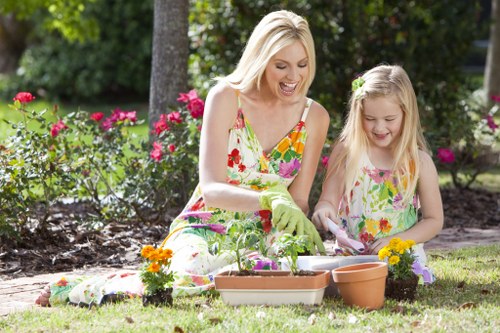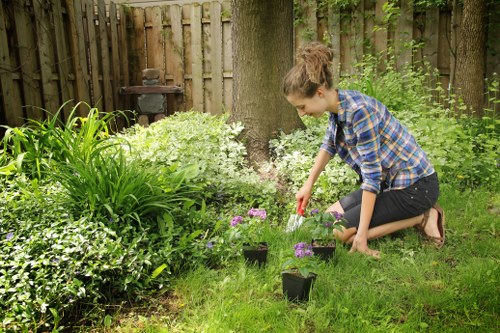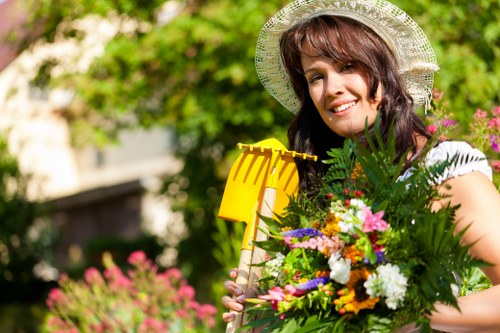Lawn Turf Installation in Garden Fence Replacement

The Importance of Comprehensive Garden Renovation
When it comes to garden makeover, two critical components often emerge: lawn turf installation and garden fence replacement. These elements not only enhance the aesthetic appeal but also improve the functionality and value of your property.
Integrating new turf with a sturdy fence can transform your outdoor space into a vibrant and secure haven. Whether you're looking to refresh an old lawn or replace a worn-out fence, understanding the synergy between these projects is essential.
In this comprehensive guide, we'll explore the key aspects of lawn turf installation and garden fence replacement, offering valuable insights to help you achieve the perfect outdoor sanctuary.

Planning Your Lawn Turf Installation
Choosing the Right Turf Type
Selecting the appropriate lawn turf is crucial for the longevity and appearance of your garden. Various types of turf cater to different climates, soil conditions, and usage patterns.
Consider factors such as sun exposure, foot traffic, and maintenance requirements when making your decision. Popular turf varieties include Bermuda grass, Zoysia grass, and Fescue, each offering unique benefits.
Preparing the Soil
Proper soil preparation is the foundation of a successful turf installation. Begin by clearing the area of weeds, rocks, and debris to create a clean slate.

Soil Testing and Amendment
Conduct a soil test to determine pH levels and nutrient content. Based on the results, amend the soil with necessary fertilizers or lime to achieve optimal conditions for turf growth.
Leveling the Ground
A smooth, even surface ensures uniform turf installation and prevents pooling of water. Use a rake or mechanical tool to level the soil, filling in low spots and removing high areas.
Installation Techniques
There are two primary methods for turf installation: sod and seeding. Sod provides an instant lawn, while seeding is more cost-effective but takes longer to establish.

Executing the Lawn Turf Installation
Laying the Turf
Begin laying the turf from one edge of the garden, ensuring each piece is tightly butted against the next to prevent gaps. Stagger the seams in a brick-like pattern for added strength and aesthetic appeal.
Watering and Maintenance
Immediate watering is essential to help the turf establish roots. Maintain consistent moisture levels during the initial weeks, gradually reducing frequency as the turf matures.
Ongoing Care
Regular mowing, fertilizing, and pest control will keep your lawn healthy and vibrant. Adapt your maintenance routine based on the specific turf type and environmental conditions.

Garden Fence Replacement: Enhancing Security and Style
Selecting the Right Fence Material
Choosing the appropriate material for your garden fence is pivotal in achieving the desired balance between durability, maintenance, and aesthetic appeal.
- Wood: Offers a natural look but requires regular maintenance.
- Vinyl: Low maintenance and available in various styles.
- Metal: Provides strength and longevity with minimal upkeep.
Design Considerations
Your fence design should complement the overall style of your garden and home. Whether you prefer a traditional picket fence or a modern sleek design, ensure it aligns with your vision.
Installation Process
Professional installation ensures that your fence is securely anchored and properly aligned. Key steps include marking fence lines, setting posts, and attaching panels with precision.
Integrating Turf and Fence Projects
Coordinating lawn turf installation with fence replacement can streamline your garden renovation process. Timing both projects appropriately ensures efficient use of resources and minimizes disruption.
For example, installing the fence first can create clear boundaries for turf placement, while laying the turf beforehand allows for easier access during fence construction.
By planning these projects in tandem, you can achieve a harmonious and well-organized garden transformation.

Budgeting for Your Garden Projects
Cost Factors for Turf Installation
Several factors influence the cost of lawn turf installation, including turf type, area size, soil preparation, and labor fees.
- Turf Type: Premium varieties like Bermuda grass may cost more upfront but offer long-term benefits.
- Area Size: Larger gardens require more materials and labor, increasing overall expenses.
- Soil Preparation: Extensive groundwork can add to the cost but ensures a healthy lawn.
Fence Replacement Costs
The cost of replacing a garden fence depends on material choice, fence length, and complexity of the design.
Budgeting Tips
To manage costs effectively, obtain multiple quotes from reputable contractors, prioritize essential features, and consider long-term maintenance expenses.

Choosing Professional Services
Benefits of Hiring Experts
Professional landscapers and fence installers bring expertise, experience, and quality assurance to your projects. They can handle complex installations, provide valuable advice, and ensure timely completion.
How to Select the Right Contractor
Research local providers, check reviews, and request portfolios of previous work. Ensure the contractor is licensed, insured, and offers warranties for their services.
What to Expect
A reliable contractor will communicate clearly, adhere to deadlines, and maintain transparency in pricing and processes. Establishing a good rapport can lead to a successful and stress-free project.

Environmental Considerations
Sustainable Turf Options
Choosing environmentally friendly turf options can contribute to a sustainable garden. Organic fertilizers, drought-resistant grass types, and eco-friendly installation practices reduce environmental impact.
Fence Materials and Sustainability
Opt for sustainable materials such as recycled metal, sustainably sourced wood, or vinyl alternatives that have a lower environmental footprint.
Water Conservation
Implementing water-efficient irrigation systems and selecting turf that requires minimal watering can conserve water and promote a healthier ecosystem.

Maintaining Your New Lawn and Fence
Lawn Care Routine
Establish a regular lawn care routine to keep your turf lush and vibrant. This includes mowing, watering, fertilizing, and pest management tailored to your turf type.
Fence Maintenance Tips
Maintain your garden fence by cleaning it regularly, inspecting for damage, and performing necessary repairs to extend its lifespan.
Seasonal Care
Adjust your maintenance practices seasonally to address specific challenges such as drying in summer or snow damage in winter.

Enhancing Curb Appeal
Complementary Landscaping Elements
Integrate other landscaping elements like flower beds, pathways, and garden lighting to complement your new lawn and fence, enhancing the overall curb appeal.
- Flower Beds: Add color and diversity to your garden space.
- Pathways: Provide structure and accessibility.
- Lighting: Highlight features and improve safety.
Final Touches
Incorporate decorative elements such as garden statues, benches, or water features to personalize your outdoor area and create a welcoming environment.
Long-Term Vision
Plan for future growth and changes in your garden to ensure that your lawn and fence remain integral parts of a dynamic and evolving landscape.
Conclusion
Combining lawn turf installation with garden fence replacement offers a comprehensive approach to transforming your outdoor space. By carefully planning and executing these projects, you can create a beautiful, functional, and secure garden that enhances your home's value and your quality of life.
Whether you choose to undertake these projects yourself or hire professionals, the key is to prioritize quality, sustainability, and aesthetic harmony. With the right strategies and care, your garden can become a cherished retreat for years to come.
Contact us today to embark on your garden renovation journey and bring your vision to life.